Update: Since this feature was written, NASA has announced that Juno will continue to observe Jupiter until July 2021.
In classical mythology, the god Jupiter surrounded himself in clouds to keep his antics hidden from view. Only his wife, Juno, could see through the veil to his true nature. And so it is with NASA’s Juno spacecraft.
The secrets of the formation of the whole Solar System lie below Jupiter’s all-encompassing clouds, just waiting to be discovered. Theories about our Solar System formation all begin with the collapse of a giant cloud of gas and dust, otherwise known as a nebula, the majority of which formed the Sun. Like the Sun, Jupiter is mostly hydrogen and helium, so it too must have formed early on, capturing most of the leftover material after our star formed.
How this happened, however, is unclear. Did a massive planetary core form first and gravitationally capture all that gas, or did an unstable region collapse inside the nebula, triggering the planet’s formation? Once processed, the data taken by Juno’s instruments will give researchers insights on how the planet formed and what the conditions in the early Solar System were like. But it also carries an instrument called JunoCam, which has taken a raft of images that so-called citizen scientists from the general public can process, and submit back to NASA. The results have been spectacular.
Clouds of ice
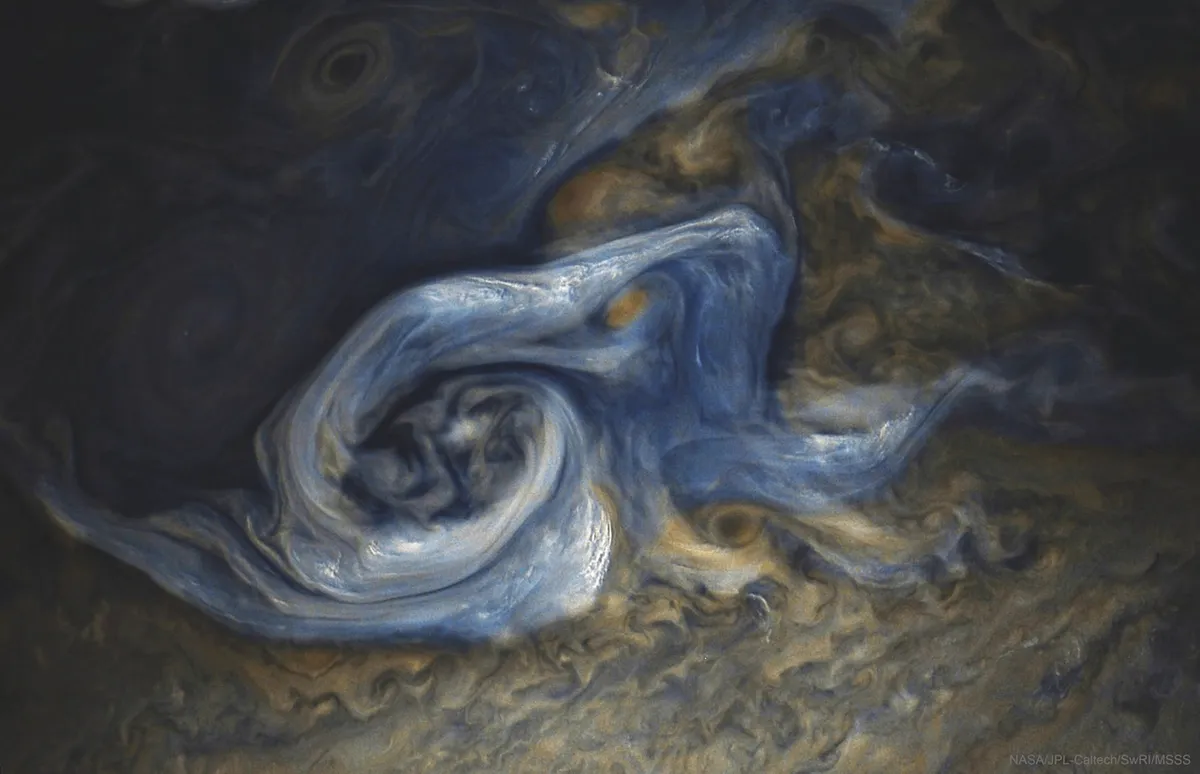
This raging storm in Jupiter’s northern hemisphere was captured during Juno’s ninth close flyby on 24 October 2017. The image was taken with the JunoCam instrument and processed by citizen scientists Gerald Eichstädt and Seán Doran to enhance the colours to bring out the details in the clouds.
The storm is rotating anticlockwise. The brighter clouds are higher in the atmosphere and catching more light, whereas the darker clouds are deeper down and so more shadowy.
In this image, the sunlight is coming from the left-hand side of the image. Both the bright clouds and their shadows measure from 7 to 12 kilometres in length and breadth. They appear to be similar to other bright clouds seen by Juno, so are probably highly reflective due to ammonia ice crystals that are borne upwards on rising currents of gas from deeper within Jupiter’s atmosphere. They may also be mixed with crystals of water ice.
Juno took this image from a distance of 10,108 kilometres.
Twister
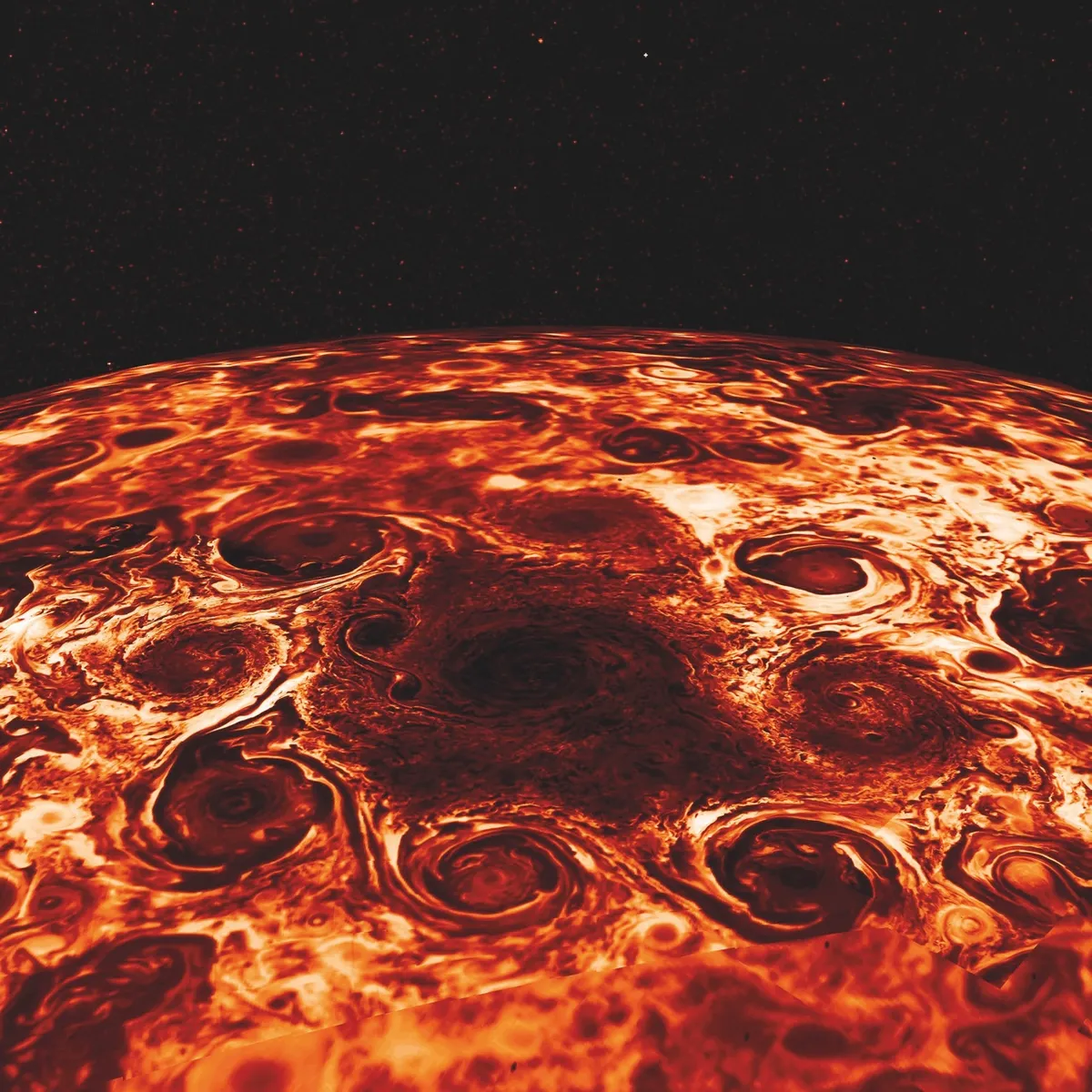
This is what Jupiter’s north pole looks like at infrared wavelengths. This composite image has been derived from data collected by the Jovian Infrared Auroral Mapper (JIRAM). These cameras detect temperatures in Jupiter’s atmosphere, which roughly correspond to the depth of the cloud features.
This image shows the central cyclone at Jupiter’s north pole and the eight cyclones that encircle it. Each cyclone is between 2,500 and 2,900 kilometres in width. The colours represent temperatures: yellow shows deeper portions of the atmosphere, which are around -13°C; the darkest areas are higher layers that are a frigid -118°C. Both these regions lie below the visible cloud layer, thus, the JIRAM instrument is giving scientists a way to see into the planet.
Finding out how heat flows through Jupiter’s atmosphere is vital to understanding the way it works, and provides clues as to how it formed. A key question being investigated is whether the planet has a rocky or metallic core at its centre.
Night and day
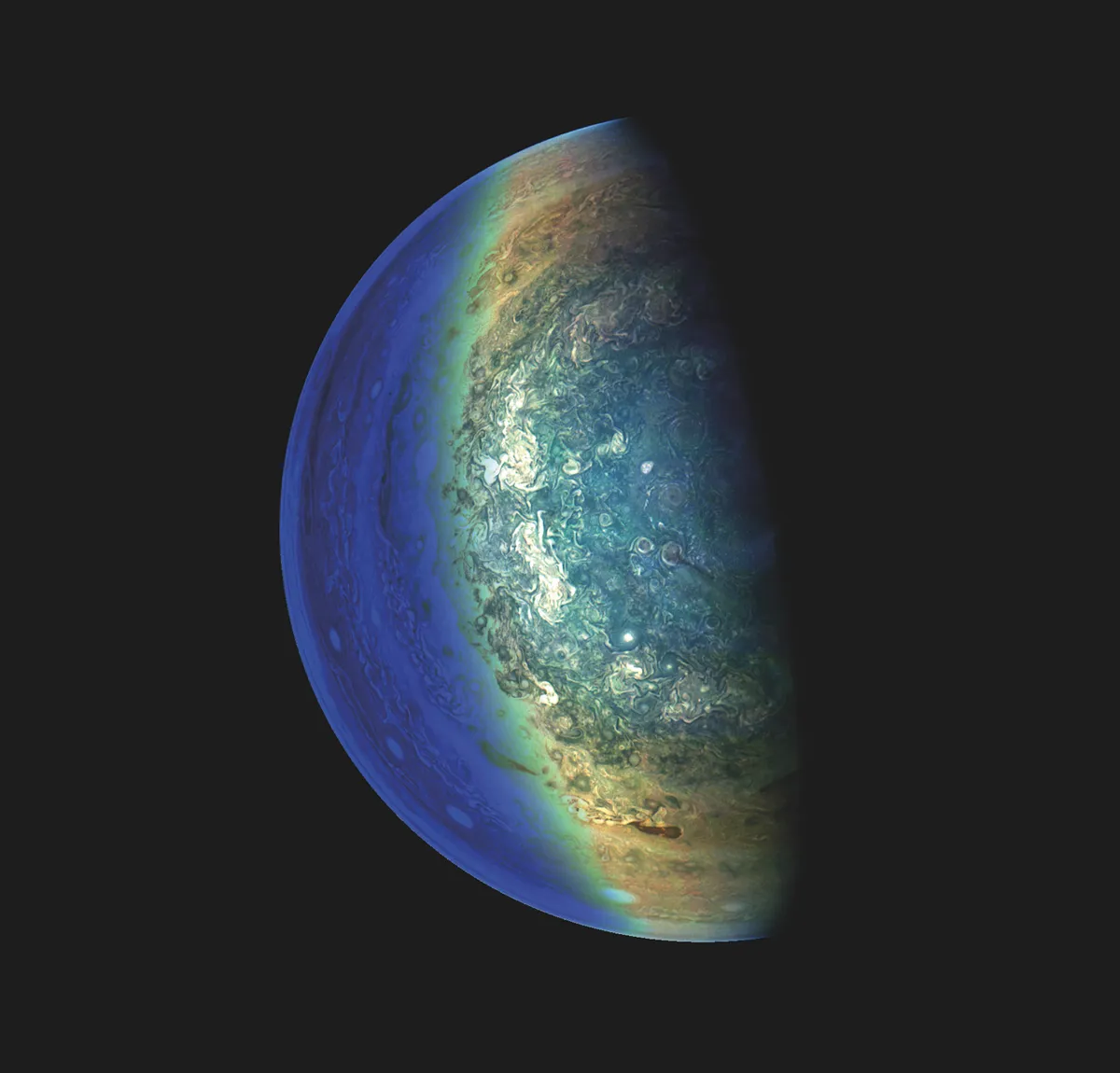
On 7 February 2018, Juno made its 11th close pass of Jupiter. This picture was taken when the spacecraft was climbing away from the planet’s south pole, and looking back at the mighty gas world.
This particular shot was taken from an altitude of 120,533 kilometres when the spacecraft was almost directly over the planet’s south pole. The colour has been enhanced over what would be seen with the naked eye.
The line separating the dayside of the planet from the nightside is called the ‘terminator’. To capture details in this ‘twilight zone’, when day is turning to night and vice-versa, the JunoCam instrument took a number of different images with different exposure times. The longer exposures showed the details of the twilight zone but overexposed the daylight side of the planet. The shorter exposures captured the bright hemisphere but failed to show anything near the terminator.
Computer processing by citizen scientist Gerald Eichstädt then merged the two images.
Eyes of the storm
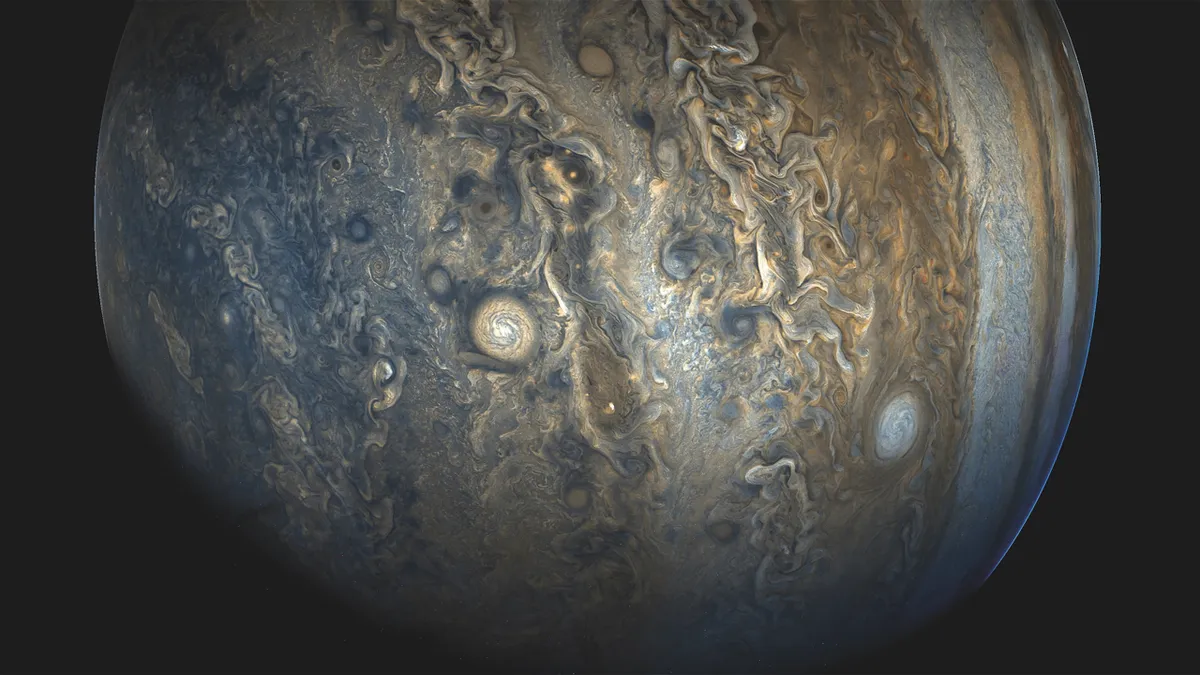
Although the Great Red Spot grabs the glory when we think about Jupiter’s giant storms, it is just one of many that rage in the planet’s atmosphere. This image shows two white storms.
It was taken by the JunoCam instrument from an altitude of 33,115 kilometres during the ninth flyby of Jupiter on 24 October 2017, and was processed by Gerald Eichstädt and Seán Doran. The image is more colourful than our eyes would see because it has been enhanced to bring out the details in the atmosphere.
The storm to the left of the image is part of Jupiter’s ‘String of Pearls’. This is a series of oval storms, all of them white in colour, that encircle the planet’s southern hemisphere at a latitude of 40°. Since 1986, the number of storms has varied from six to nine. There are currently eight of these storms, all rotating in an anticlockwise direction. These vast storms are being powered by heat that is generated in Jupiter’s interior.
Alien aurora
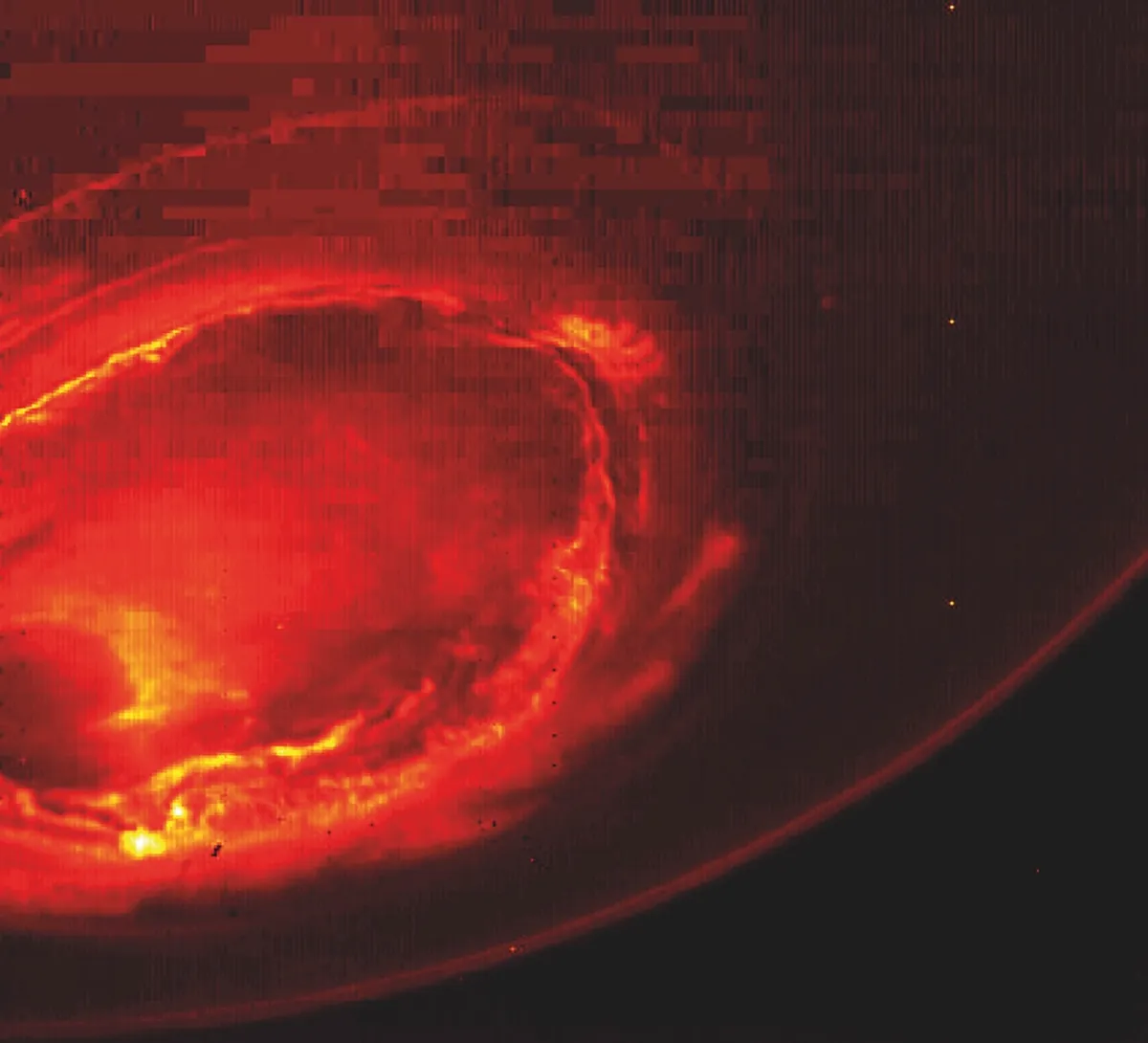
This infrared image gives an unprecedented view of the southern aurora of Jupiter. The view is a mosaic of three images taken minutes apart as the craft was pulling away from Jupiter, after its first close approach. From Earth, the planet’s southern aurora can hardly be seen.
It was captured by Juno’s Jovian Infrared Auroral Mapper (JIRAM) on 27 August 2016.
Auroras are ovals of light that occur when particles from the Sun strike molecules in a planet’s atmosphere and cause them to glow. The auroras appear as ovals because the magnetic field of the planet corrals the solar particles into a cone-shaped funnel that feeds them into the atmosphere around the planet’s magnetic poles. The same occurs at Earth, but as Jupiter’s magnetic field is the strongest planetary field in the Solar System – fully 20,000 times stronger than Earth’s – its auroras are stronger.
This image is composed of wavelengths longer than visible light, ranging from 3.3 to 3.6 micrometres (one micrometre = one-thousandth of a millimetre). These wavelengths were chosen because they are the ones emitted by excited hydrogen ions. These are atoms that have lost an electron particle and dominate the planet’s atmosphere.
On the spot
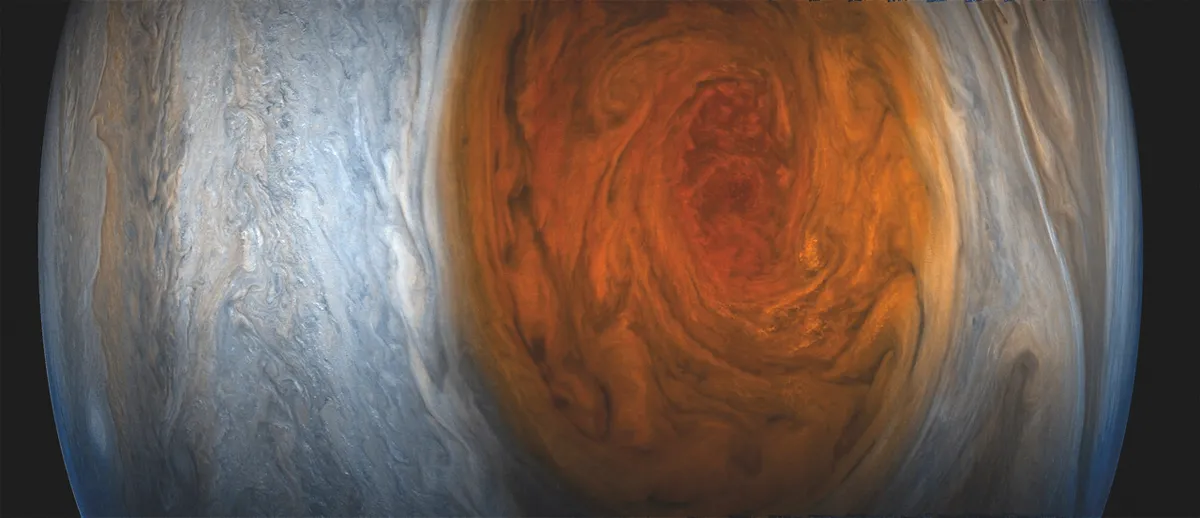
If you were to compose a list of the seven wonders of the Solar System, Jupiter’s Great Red Spot would be near the top. This gigantic storm system is bigger than planet Earth, and rotates in an anticlockwise fashion with a period of about six days.
Although a large circular storm has been reported on Jupiter from the 1660s onwards, it may not be the one we see today. Records are poor between 1713 and 1831 and may indicate that the original storm dissipated, and that the Great Red Spot we see today ‘only’ formed in the 19th Century.
This image is an artistic endeavour based on real data. Citizen scientist Gerald Eichstädt used data from the JunoCam instrument and enhanced the colour to draw the eye into the storm.
The raw image was taken on 10 July 2017, during Juno’s 7th close flyby of the planet. When the image was taken, the craft was about 10,000 kilometres above the planet’s cloud tops.
This article first appeared in issue 322 of BBC Focus magazine – check out the latest subscription deals here.